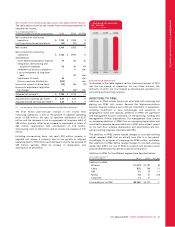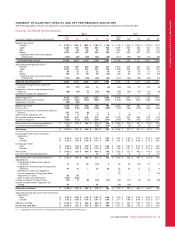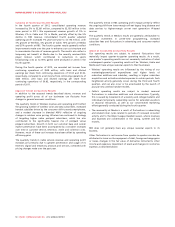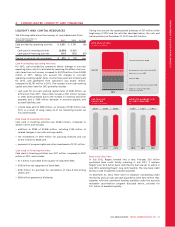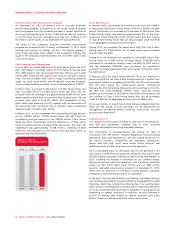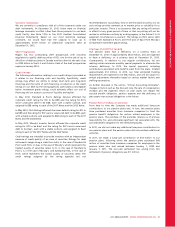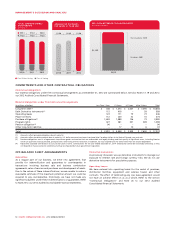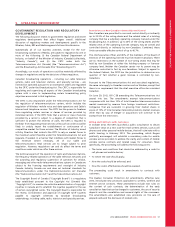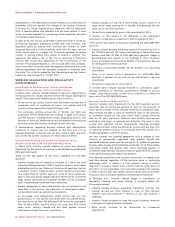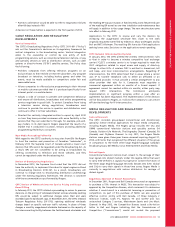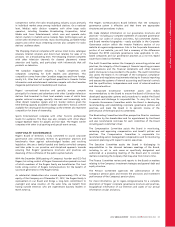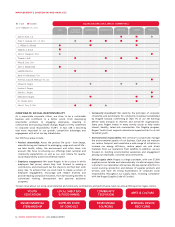Rogers 2012 Annual Report Download - page 57
Download and view the complete annual report
Please find page 57 of the 2012 Rogers annual report below. You can navigate through the pages in the report by either clicking on the pages listed below, or by using the keyword search tool below to find specific information within the annual report.
MANAGEMENT’S DISCUSSION AND ANALYSIS
Covenant Compliance
We are currently in compliance with all of the covenants under our
debt instruments. At December 31, 2012, there were no financial
leverage covenants in effect other than those pursuant to our bank
credit facility (see Note 17(h) to the 2012 Audited Consolidated
Financial Statements). Based on our most restrictive leverage
covenants, we would have had the capacity to issue up to
approximately $10.9 billion of additional long-term debt at
December 31, 2012.
Shelf Prospectuses
Rogers has two outstanding shelf prospectuses with securities
regulators to qualify debt securities of RCI, one for the sale of up to
$4 billion of debt securities in Canada and the other for the sale of up
to US$4 billion in the U.S. and Ontario. Each of the shelf prospectuses
expires in January 2014.
Credit Ratings
The following information relating to our credit ratings is provided as
it relates to our financing costs and liquidity. Specifically, credit
ratings may affect our ability to obtain short-term and long-term
financing and the terms of such financing. A reduction in the credit
ratings on our debt by the rating agencies, particularly a downgrade
below investment grade ratings, could adversely affect our cost of
financing and our access to sources of liquidity and capital.
In May 2012, Standard & Poor’s Ratings Services affirmed the
corporate credit rating for RCI to be BBB and the rating for RCI’s
senior unsecured debt to be BBB, each with a stable outlook, and
assigned its BBB rating to each of the 2017 Notes and the 2022 Notes.
In May 2012, Fitch Ratings affirmed the issuer default rating for RCI to
be BBB and the rating for RCI’s senior unsecured debt to be BBB, each
with a stable outlook, and assigned its BBB rating to each of the 2017
Notes and the 2022 Notes.
In May 2012, Moody’s Investor Service affirmed the corporate credit
rating for RCI to be Baa1 and the rating for RCI’s senior unsecured
debt to be Baa1, each with a stable outlook, and assigned its Baa1
rating to each of the 2017 Notes and the 2022 Notes.
Credit ratings are intended to provide investors with an independent
measure of credit quality of an issue of securities. Ratings for debt
instruments range along a scale from AAA, in the case of Standard &
Poor’s and Fitch, or Aaa, in the case of Moody’s, which represents the
highest quality of securities rated, to D, in the case of Standard &
Poor’s, C, in the case of Moody’s, and Substantial Risk, in the case of
Fitch, which represents the lowest quality of securities rated. The
credit ratings assigned by the rating agencies are not
recommendations to purchase, hold or sell the rated securities, nor do
such ratings provide comment as to market price or suitability for a
particular investor. There is no assurance that any rating will remain
in effect for any given period of time, or that any rating will not be
revised or withdrawn entirely by a rating agency in the future if in its
judgment circumstances so warrant. The ratings on RCI’s senior debt
of BBB from Standard & Poor’s and Fitch and of Baa1 from Moody’s
all represent investment grade ratings.
Employee Benefit Plan Funding
Our pension plans had a deficiency on a solvency basis at
December 31, 2012 of approximately $334 million, and are expected
to have a deficiency on a solvency basis at December 31, 2013.
Consequently, in addition to our regular contributions, we are
making certain minimum monthly special payments to eliminate the
solvency deficiency. In 2012, the special payments, including
contributions associated with benefits paid from the plans, totalled
approximately $10 million. In 2013, our total estimated funding
requirements are expected to be $96 million, and will be subject to
annual adjustments thereafter based on various market factors and
staffing assumptions.
As further discussed in the section “Critical Accounting Estimates”,
changes in factors such as the discount rate, the rate of compensation
increase and the expected return on plan assets can impact the
accrued benefit obligation, pension expense and the deficiency of
plan assets over accrued obligations in the future.
Pension Plans Purchase of Annuities
From time to time the Company has made additional lump-sum
contributions to our pension plans and, in turn, the pension plans
have purchased annuities from insurance companies to fund the
pension benefit obligations for certain retired employees in the
pension plans. The purchase of the annuities relieves us of primary
responsibility for, and eliminates significant risk associated with, the
accrued benefit obligation for the retired employees.
In 2012, we did not make any additional lump-sum contributions to
our pension plans and the pension plans did not purchase additional
annuities.
In 2011, we made a lump-sum contribution of $18 million to our
pension plans, following which the pension plans purchased $68
million of annuities from insurance companies for employees in the
pension plans who had retired between January 1, 2009 and
January 1, 2011. The non-cash settlement loss arising from this
settlement of pension obligations was $11 million.
2012 ANNUAL REPORT ROGERS COMMUNICATIONS INC. 53






